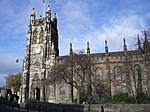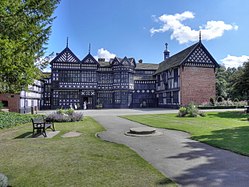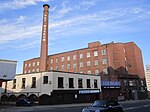History
The building was designed by Henry Bowman as the headquarters of the 4th Administrative Battalion, Cheshire Rifle Volunteer Corps in 1862. [2] The unit evolved to become the 4th Volunteer Battalion, The Cheshire Regiment in 1883 and the 6th Battalion, Cheshire Regiment in 1908. [3] The battalion was mobilised at the drill hall in August 1914 before being deployed to the Western Front [4] and then being disbanded in 1920. [3]
After the war, a new 6th (Cheshire and Shropshire) Medium Brigade, Royal Garrison Artillery, was formed at the Armoury from the Cheshire Brigade, Royal Field Artillery, incorporating the former 6th Bn Cheshire Regiment and the Shropshire Royal Horse Artillery. In 1921, the new unit was redesignated 60th (6th Cheshire and Shropshire) Medium Brigade, RGA. [5] [6] [7] In the late 1930s, the unit was converted into 81st Heavy Anti-Aircraft Regiment, Royal Artillery, which saw service in The Blitz, in the Orkney and Shetland Defences, and in the Middle East during World War II. After the war it became 360th (Mobile) Heavy AA Regiment, but was amalgamated with other regiments in Manchester when Anti-Aircraft Command was disbanded in 1955. [6]
"A" Company, the Mercian Volunteers was formed at the Armoury in 1967 and evolved to become the "A" Company, the 3rd (Volunteer) Battalion, The Cheshire Regiment in 1988 and Salerno Company, the Fire Support Battalion, The Cheshire Regiment in 1995. [8] The presence at the Armoury was reduced to a mortar platoon of "B" (Cheshire) Company, The King's and Cheshire Regiment in 1999, of "A" (Cheshire) Company, The West Midlands Regiment in 2006 and of "A" (Cheshire) Company, 4th Battalion, The Mercian Regiment in 2007. [8] The Armoury is still an active Army Reserve Centre. [9]
This page is based on this
Wikipedia article Text is available under the
CC BY-SA 4.0 license; additional terms may apply.
Images, videos and audio are available under their respective licenses.






